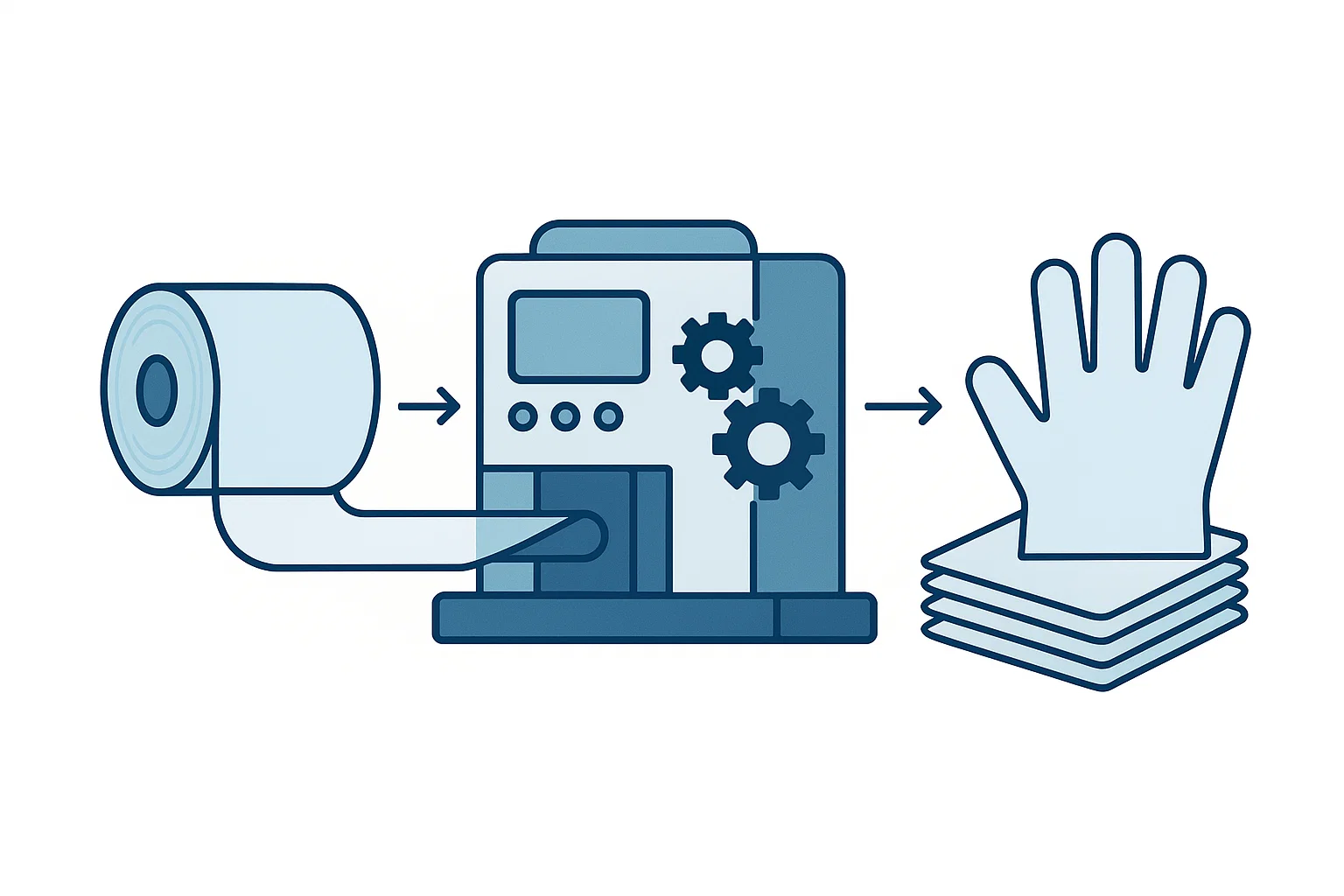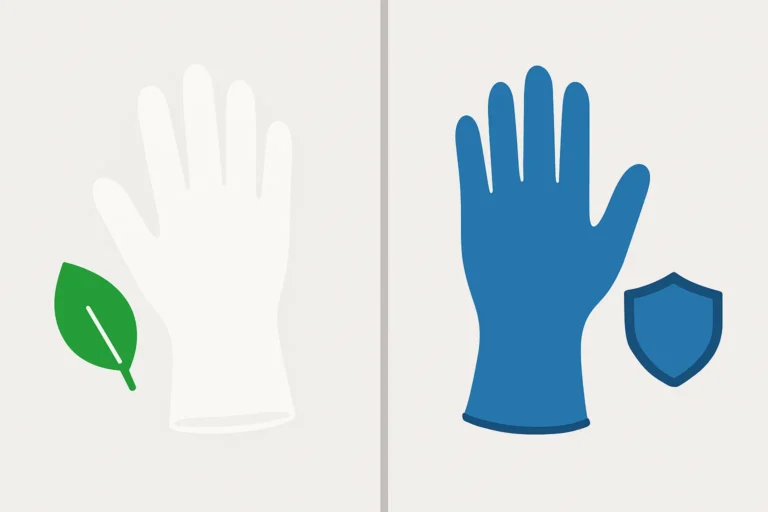Wat is een machine voor plastic wegwerphandschoenen?
In sectoren waar hygiëne en veiligheid van het grootste belang zijn, zoals de gezondheidszorg, de voedingssector en cleanrooms, zijn wegwerphandschoenen een onmisbaar onderdeel van de dagelijkse werkzaamheden. Maar hebt u ooit stilgestaan bij de technologie achter de productie van deze essentiële artikelen? De onbezongen held van dit proces is de plastic wegwerphandschoenen machineeen geavanceerd apparaat dat ontworpen is voor precisie, snelheid en betrouwbaarheid. Voor inkopers en professionals in de industrie is het van cruciaal belang om de mechanica en mogelijkheden van deze machines te begrijpen om weloverwogen investeringsbeslissingen te kunnen nemen die de operationele efficiëntie en productkwaliteit aanzienlijk kunnen beïnvloeden.
Van grondstof tot eindproduct is de weg van een wegwerphandschoen een wonder van moderne automatisering. In deze uitgebreide gids duiken we in de wereld van de productie van wegwerphandschoenen en gaan we in op de ingewikkelde processen, de verschillende soorten beschikbare machines en de belangrijkste kenmerken die een productielijn van hoge kwaliteit definiëren. We belichten ook hoe industrieleiders zoals Damao Tec verleggen de grenzen van innovatie om machines te leveren die voldoen aan de veranderende eisen van de wereldmarkt.
De evolutie van handschoenproductie: Van handarbeid tot snelle automatisering
De productie van wegwerphandschoenen is in de loop der decennia ingrijpend veranderd. De vroegere methodes waren arbeidsintensief en traag, wat vaak resulteerde in een ongelijke kwaliteit. De komst van de automatisering veroorzaakte een revolutie in de sector en maakte de weg vrij voor machines die duizenden handschoenen per uur konden produceren met minimale menselijke tussenkomst. Deze verschuiving verhoogde niet alleen de productievolumes, maar verbeterde ook de hygiënenormen door het manueel contact tijdens het productieproces te beperken.
De hypermoderne wegwerphandschoenmachines van tegenwoordig, zoals die van Damao Tecvertegenwoordigen het hoogtepunt van deze evolutie. Door de integratie van geavanceerde robotica, intelligente besturingssystemen en precisietechniek bieden deze machines een ongeëvenaarde efficiëntie, consistentie en veelzijdigheid, waardoor ze een hoeksteen vormen van de moderne productie van persoonlijke beschermingsmiddelen (PBM's).
Hoe werkt een machine voor plastic wegwerphandschoenen? Een stap voor stap uitleg
Hoewel er verschillende machines bestaan voor verschillende materialen zoals PE en TPE, omvat het fundamentele proces om plastic folie om te zetten in een afgewerkte handschoen verschillende belangrijke stappen. Een moderne, volautomatische lijn automatiseert elke stap voor een naadloze workflow.
1. Materiaal toevoeren en afwikkelen
Het proces begint met een grote rol plastic folie - meestal polyethyleen (PE) of thermoplastisch elastomeer (TPE) - die op de machine wordt geladen. Een geautomatiseerd afwikkelsysteem, vaak aangestuurd door een frequentieomvormer, voert de folie met hoge precisie toe om een soepele en consistente toevoer naar de productielijn te garanderen.
2. Filmvorming en verwarming
Voor bepaalde handschoentypes, vooral die van materialen zoals CPE (gechloreerd polyethyleen) of TPE, vormt de machine eerst twee lagen film parallel. Die lagen worden dan verwarmd tot de optimale temperatuur om ze voor te bereiden op de cruciale vormfase. Dit verwarmingsproces zorgt ervoor dat het materiaal plooibaar genoeg is om nauwkeurig te worden geseald en gesneden.
3. Handschoenen maken, sealen en snijden
Dit is de kern van het productieproces waar de handschoen vorm krijgt. De verwarmde plastic film gaat door een station dat is uitgerust met een handgevormde mal. De machine gebruikt een hitte- en snijmechanisme om de lagen folie samen te persen, waarbij tegelijkertijd de randen worden gelast en de omtrek van de handschoen wordt uitgesneden. De kwaliteit en precisie van deze mal zijn van het grootste belang om een handschoen te maken die niet alleen perfect gevormd is, maar ook sterke, betrouwbare naden heeft. Bedrijven zoals Damao Tec investeren zwaar in de engineering van deze matrijzen om consistentie en duurzaamheid te garanderen.
4. Automatisch afval strippen
Zodra de vorm van de handschoen gesneden is, moet de overtollige folie eromheen, bekend als afvalmateriaal, verwijderd worden. Bij oudere, halfautomatische systemen was hiervoor handenarbeid nodig. In een volautomatische machine voor wegwerphandschoenen is echter een automatische afvalstripeenheid geïntegreerd. Dit systeem scheidt het afval mechanisch van de afgewerkte handschoenen, die dan voor recyclage kunnen worden ingezameld, wat de duurzaamheid verbetert en de manuele arbeid vermindert.
5. Tellen en stapelen
In de laatste fase worden de afgewerkte handschoenen automatisch geteld en gestapeld. Geavanceerde systemen maken gebruik van sensoren om nauwkeurige tellingen te garanderen voordat de handschoenen netjes gestapeld worden, klaar om verpakt te worden. Deze automatisering beperkt de handling tot een minimum, houdt de hygiëne op peil en bereidt het product efficiënt voor op de distributie.
Soorten plastic wegwerphandschoenen en hun gespecialiseerde machines
De term "kunststof handschoenen" dekt een hele reeks materialen, die elk geschikt zijn voor verschillende toepassingen en specifieke machineconfiguraties vereisen.
- PE (Polyethyleen) Handschoenmachines: PE-handschoenen, gemaakt van polyethyleen met hoge dichtheid (HDPE) of lage dichtheid (LDPE), zijn het meest gangbare en voordeligste type plastic wegwerphandschoen. Ze worden veel gebruikt in de voedingsindustrie voor taken waarbij de handschoenen vaak moeten worden vervangen. PE-handschoenmachines zijn ontworpen om deze lichte handschoenen op hoge snelheid te produceren.
- TPE (Thermoplastisch Elastomeer) Handschoenmachines: TPE handschoenen bieden een aanzienlijke verbetering ten opzichte van standaard PE handschoenen. Ze zijn zachter, flexibeler en elastischer dan vinyl handschoenen. TPE machines, zoals die ontwikkeld door Damao Teczijn ontworpen om met de unieke eigenschappen van dit materiaal om te gaan en zorgen voor een afwerking van hoge kwaliteit en een comfortabele gebruikerservaring.
- CPE (gechloreerd polyethyleen) handschoenmachines: CPE handschoenen staan bekend om hun duurzaamheid en zachte gevoel. De productiemachines voor CPE handschoenen zijn vergelijkbaar met die van TPE, met een filmgiet- of blaasproces, gevolgd door thermische verzegeling en snijden.
Belangrijkste kenmerken om te overwegen bij het investeren in een machine voor plastic wegwerphandschoenen
Voor inkopers en productiemanagers is het kiezen van de juiste machine een cruciale beslissing die van invloed is op de productiviteit, de kosten en het concurrentievermogen op de markt. Dit zijn de essentiële kenmerken die je moet evalueren:
- Productiesnelheid en -capaciteit: Zoek een machine die aan je volume-eisen kan voldoen. Hogesnelheidsmodellen kunnen 40 tot meer dan 140 stuks per minuut per lijn produceren, en veel machines hebben een opstelling met twee lijnen om de uitvoer te verdubbelen.
- Automatiseringsniveau: A volautomatische machine voor wegwerphandschoenen vermindert de arbeidskosten en de kans op menselijke fouten aanzienlijk. Functies zoals automatische afvalverwijdering, tellen en stapelen zijn essentieel voor een echt efficiënte en hygiënische productielijn.
- Compatibiliteit en veelzijdigheid van materialen: Een machine die verschillende materialen zoals PE, CPE en TPE kan verwerken, biedt meer flexibiliteit om te voldoen aan uiteenlopende marktbehoeften en om zich aan te passen aan veranderende klanteneisen. De mogelijkheid om vormen en maten van handschoenen aan te passen is ook een belangrijk voordeel.
- Bouwkwaliteit en betrouwbaarheid van onderdelen: De levensduur en prestaties van de machine hangen af van de constructie en de kwaliteit van de onderdelen. Zoek naar machines met een robuust stalen frame voor stabiliteit en uitgerust met betrouwbare elektronica van gerenommeerde merken. Damao Tecmaakt bijvoorbeeld gebruik van een microcomputer touchscreen en hoogwaardige componenten voor een betrouwbare, geluidsarme werking.
- Energie-efficiëntie en bedrijfskosten: In de huidige concurrerende markt is het minimaliseren van de operationele kosten van groot belang. Een energiezuinig ontwerp verlaagt niet alleen de elektriciteitsrekening, maar draagt ook bij aan een duurzamer productieproces, waardoor de investering sneller wordt terugverdiend.
- Klantenservice en technische ondersteuning: Een betrouwbare fabrikant biedt uitgebreide ondersteuning, inclusief installatie, training en direct beschikbare reserveonderdelen. Dit partnerschap is cruciaal voor het garanderen van minimale stilstandtijd en het behouden van piekproductie-efficiëntie.
Waarom Damao Tec de norm stelt in wegwerphandschoenmachinetechnologie
Op het gespecialiseerde gebied van de productie van beschermingsmiddelen, Damao Tec heeft zichzelf gevestigd als een betrouwbare leider door een niet aflatende toewijding aan kwaliteit, innovatie en klantgerichtheid. Onze diepgewortelde Ervaring in de industrie wordt weerspiegeld in het robuuste ontwerp en de superieure prestaties van onze machines. We demonstreren onze Expertise door de integratie van geavanceerde automatisering en intelligente besturingssystemen die onze klanten in staat stellen om een ongeëvenaarde productie-efficiëntie te bereiken.
Onze Gezaghebbendheid is gebouwd op een fundament van bewezen succes, met Damao Tec machines die werken in fabrieken over de hele wereld en consistent producten van hoge kwaliteit leveren. Het belangrijkste is dat we de Betrouwbaarheid door transparante processen, betrouwbare aftersalesondersteuning en machines die gemaakt zijn om lang mee te gaan. Door te kiezen voor Damao TecU koopt niet zomaar een machine; u investeert in een partnerschap dat toegewijd is aan uw succes.
De toekomst van handschoenproductie: Duurzaamheid en slimme technologie
De toekomst van de productie van wegwerphandschoenen wordt bepaald door twee belangrijke trends: duurzaamheid en slimme technologie. Fabrikanten zijn steeds meer op zoek naar machines die afval tot een minimum beperken en biologisch afbreekbare of recycleerbare materialen kunnen verwerken. Tegelijkertijd zal de integratie van IoT (Internet of Things) en AI-gestuurde analyses "slimme" productielijnen mogelijk maken die zelf problemen kunnen diagnosticeren, de prestaties in realtime kunnen optimaliseren en waardevolle gegevens voor de productieplanning kunnen leveren. Damao Tec is actief bezig met onderzoek en ontwikkeling om deze toekomstgerichte eigenschappen in onze volgende generatie plastic wegwerphandschoenmachines te integreren.
Conclusie
De plastic wegwerphandschoenen machine is van cruciaal belang voor elke fabrikant in de PBM-, voedingsmiddelen- of medische toeleveringsindustrie. Het is meer dan alleen een apparaat, het is de motor van de productie en heeft een directe invloed op de output, kwaliteit en winstgevendheid. Door het ingewikkelde productieproces, de verschillende machinetypen en de belangrijkste kenmerken te begrijpen, kunnen inkopers en professionals in de sector strategische investeringen doen die voordelen op de lange termijn opleveren.
Omdat automatisering en technologie zich blijven ontwikkelen, is een samenwerking met een ervaren en innovatieve fabrikant als Damao Tec zorgt ervoor dat je de tools en ondersteuning hebt die nodig zijn om te floreren in een concurrerend landschap, door essentiële producten te leveren die mensen en processen over de hele wereld beschermen.
Veelgestelde vragen (FAQ)
1. Wat is het belangrijkste verschil tussen een halfautomatische en een volautomatische machine voor plastic wegwerphandschoenen?
Een halfautomatische machine vereist meestal handmatige tussenkomst voor bepaalde processtappen, meestal het verwijderen van de afvalfolie na het snijden van de handschoenen. Een volautomatische machine daarentegen integreert geautomatiseerde systemen voor elke stap, inclusief materiaaltoevoer, sealen, snijden, afvalverwijdering en tellen, waardoor de arbeidskosten aanzienlijk dalen en de efficiëntie toeneemt.
2. Welke grondstoffen kan een veelzijdige machine voor plastic wegwerphandschoenen verwerken?
Hoogwaardige, veelzijdige machines zijn ontworpen om compatibel te zijn met een reeks thermoplastische folies. De meest voorkomende materialen zijn HDPE (High-Density Polyethylene) en LDPE (Low-Density Polyethylene). Veel geavanceerde modellen, waaronder die van Damao TecOok CPE-folies (gechloreerd polyethyleen) en TPE-folies (thermoplastisch elastomeer) kunnen efficiënt worden verwerkt, zodat fabrikanten verschillende soorten handschoenen kunnen produceren om te voldoen aan diverse marktbehoeften.
3. Hoeveel onderhoud heeft een machine voor plastic wegwerphandschoenen nodig?
Moderne machines zijn ontworpen met het oog op duurzaamheid en onderhoudsgemak. Regelmatig onderhoud bestaat meestal uit het reinigen van de seal- en snijmatrijzen, het controleren van de spanning van het toevoersysteem en het controleren of de elektronische componenten en besturingssystemen correct functioneren. Machines met componenten van hoge kwaliteit en handige smeersystemen vereenvoudigen dit proces en zorgen voor een langere levensduur en consistente prestaties.
4. Kan de handschoengrootte en -vorm op de machine worden aangepast?
Ja, een van de belangrijkste kenmerken van moderne wegwerphandschoenmachines is de mogelijkheid om het product aan te passen. De vorm en grootte van de handschoen worden bepaald door de mal die in het seal- en snijstation wordt gebruikt. Deze mallen zijn vaak onderling verwisselbaar, zodat fabrikanten verschillende maten (bv. klein, middelgroot, groot) en zelfs aangepaste vormen kunnen produceren om aan specifieke toepassingen of klanteneisen te voldoen.


